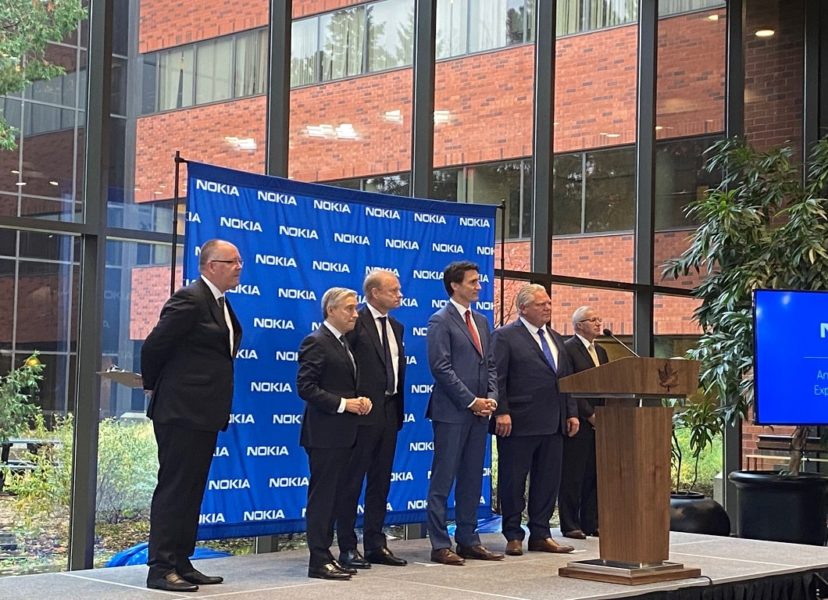Ontario will be the first province to see Nokia’s 5G technology integrated into its infrastructure
Earlier this year, Canada scrapped any idea of using Huewai’s 5G network implemented throughout the country. As a result, other Western nations banned the global tech giant for unproven speculations that Huewai’s technology would spy on Canadians.
That decision to ostracize the global leader in 5G technology left Canadians behind the eight ball without a clear plan from the government until today, with the announcement of Nokia coming on board to begin building the country’s 5G infrastructure.
The Ontario government has secured a $340 million investment by telecommunications giant Nokia Corporation to expand its operations in Canada. This investment will support Nokia’s new Canadian headquarters in Kanata and create hundreds of high-skilled, good-paying jobs.
As part of the deal, the government of Ontario will provide a $30 million loan to Nokia and see another $40 kicked in by the Federal government.
The funds will go towards new R&D to make Ontario the hub position itself as a global leader in advanced technology, cyber security, artificial intelligence and machine learning.
“This monumental investment from Nokia shows once again that there is no better place for businesses to grow and jobs to be created than here in Ontario,” said Premier Doug Ford. “We are proud to work alongside our partners to secure hundreds more in demand, high skill jobs for the Ottawa region and we welcome this long-term commitment from Nokia to our province, and our workers.”
“The project we’re announcing will help connect Canadians to the jobs of today and tomorrow. It will bring economic benefits to the National Capital Region and stimulate Canada’s tech ecosystem. This is about building a strong economy and a better future for everyone.” The Rt. Hon. Justin Trudeau, Prime Minister of Canada
“Nokia is helping to drive Ontario’s tech leadership. This world-class, sustainable R&D hub will be one of Nokia’s most dynamic developments that will create cutting-edge innovations and solutions to advance the global technology ecosystem.” Pekka Lundmark President and CEO of Nokia
5G technology is on the horizon and is expected to revolutionize the world as we know it. Many new technologies have been created thanks to telecommunications, and 5G promises to be just as revolutionary. This next generation of wireless connectivity allows for faster data speeds, more extensive networks, greater network security and more efficient applications. However, it will take time for 5G to reach its full potential.
High-frequency 5G technology has the potential to cover far more geographical areas at incredible speeds. This is thanks to the higher frequency bands available for use; frequencies above 20 GHz are possible with 5G transmission. Compared to 4G, 5G can cover greater distances with less interference. A single cell tower used for 4G transmission can be repurposed for 5G with a larger footprint. To that end, companies are working overtime to perfect the next generation of wireless technology.
Different companies have begun developing various types of 5G technologies. Some focus on short-range connectivity for public transport, while others work on ultra-high frequency spectrums for medical applications or the space industry. Some countries are ahead of others in developing and implementing new technologies based on their needs. For example, China and the United States have invested heavily in high-frequency technology, while India and Japan have focused on low-frequency spectrums for more excellent coverage. Eventually, all countries will have a stable 5G network regardless of their needs.
Once deployed, a 5G network can transmit vast amounts of data in seconds instead of minutes. Companies will use this advantage to deliver more dynamic applications at faster speeds. These include autonomous cars and drones that deliver food or packages instantly to homes or businesses. Plus, 5G will enable users to stream high-quality video or audio without causing lag or distortion.
This is thanks to greater range capabilities and reduced latency – the time it takes for a request to return a response – for users in remote areas.
5G has a lot of potential for business use cases. Large corporations can use this technology to quickly solve issues in their offices without affecting regular operations. Smaller businesses can use high frequencies for online chatting with customers or transferring large amounts of data between computers and computers. The fibre optic industry will likely reduce their reliance on expensive physical cables when 5G becomes available.
The average consumer doesn’t need 5G yet; 4G LTE is sufficient for most needs today. However, it’s good news that in most markets, Ericsson plans to have 5G out by the end of 2019. As companies work toward deploying this new technology, they need time to perfect their processes and make necessary changes within their workplaces. Once that’s taken care of, consumers will benefit from increased network speeds and new applications we can’t yet imagine.
Although 5G technology is still far from its full potential, the groundwork is being laid rapidly these days. High-frequency 5G has already been deployed successfully in some parts of the world- but most companies are still working toward deploying lower-frequency spectrums internationally. There’s no doubt that once fully operational, this new generation of wireless connectivity will change how we live our daily lives forever!
Image source, PM Twitter feed









